How to Inspect Your Roof for Hail Damage
Summer in Colorado oftentimes means late afternoon thunderstorms and hail. While pea-sized hail is unlikely to do any damage, hail 1” in diameter (quarter-sized) and larger can be detrimental to your roof. If you’ve recently had a storm roll through your area with decent-sized hail, you may be curious to know if there was any hail damage to your roof. Depending on the extent of the damage, you may need some repairs.
There are a few things you need to think about before assessing your hail damage roof. Firstly, you need to ensure that you are safe. That is why hail damage roof assessments are often left to experienced professionals. Secondly, you must know there may not be damage to just your roof, but also to gutters and downspouts. That’s a good place to start when assessing the damage. It’s important to check roof elements such as chimneys and roof vents, as well.
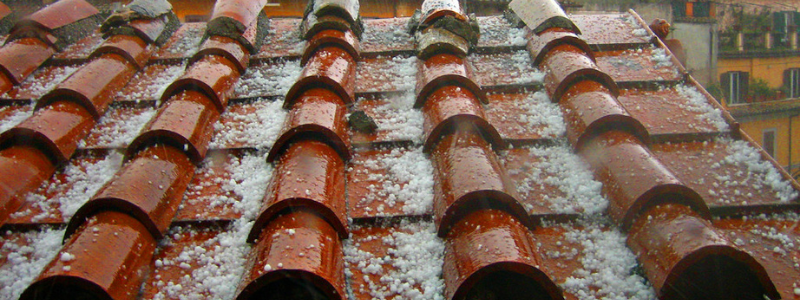
What Hail Can Do to Your Roof
Hail can do a lot to damage your roof. Not only can it damage the roof itself, but it can also damage roof elements like vents, chimneys, skylights, gutters, and more. A hail damage roof can be compromised depending on the extent of the damage. Hail damage to your roof can cause things like:
- Loss of protective shingle granules
- Cracks in shingles
- Exposed sub-surface materials
- Weakened seals
All of these things can lead to leaks in your roof, or worse. That’s why it’s important to be on top of the damage so that you get it assessed and repaired before it becomes a major issue.
Inspecting Your Roof for Hail Damage
Once you understand what hail damage can look like and the effects it may have on your home, you can start to inspect your hail damage roof. However, if you are uncertain about the safety of your inspection or are unsure how much damage was caused, it’s a good idea to call a professional. Here is how to inspect your roof for hail damage:
Safety First
Before you get up on your roof, we want to remind you that safety should be your first priority. Plan on wearing soft-soled shoes or roofing boots for safe walking on your roof. Always check that your ladder is in perfect working condition and bring some chalk to mark up any damaged areas. Never go up on your roof alone, always have someone outside with you!
Start With Obvious Damage
By looking for damage to gutters and downspouts, you can bet that your roof sustained some damage, too. Make your way around your home to take inventory of damage on some of those items. You may also look for damage to window sills, siding, and even your air conditioner.
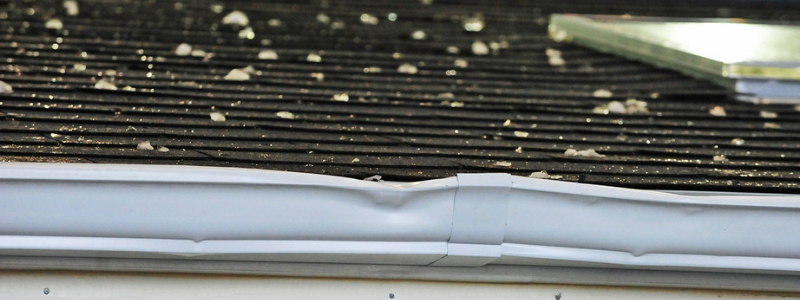
Inspect the Roof Features
Once you’ve inspected damage around the roof, it’s time to get on the roof. In addition to the roof itself, it’s also important to inspect roof features on your hail damage roof that may have also been impacted. Check all of the features that could have sustained damage, like roof vents, chimneys, and skylights.
For hard to inspect areas like chimney covers, or other places where the damage isn’t obvious, there is an easy solution. Bring a stick of chalk up to the roof with you. Turn your chalk sideways and run it over the surface. This will show you where there are dents and divots, thus uncovering hail impact points.
Inspect the Shingles
Hail damage to shingles isn’t always completely obvious. Figuring out the extent of the damage usually takes a trained eye. However, if you are choosing to inspect the damage yourself, here is what to look for:
- Obvious dents or divots
- Random round impact areas
- Dark-colored circles
- Areas where granules have been knocked off the shingle
If granules have been knocked off a shingle, this means that the hail has compromised the integrity of the shingle. This can cause leaks can develop over time. Circle each impact spot that you find with chalk to keep track of the extent of the damage.
When to Call a Professional
It is important to understand that roof inspection and repair are not things that can always be safely and easily done by anyone. Roofing professionals are trained and experienced in inspecting damaged roofs, assessing the damage, and coming up with an appropriate plan for repair. Whether a single shingle is damaged, or the entire roof and its features have been compromised by hail, it’s best to leave the assessment to experienced professionals.
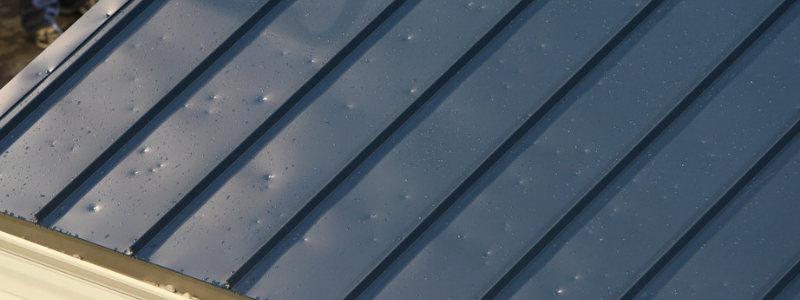
How B&M Roofing Can Help
B&M Roofing has been in the business of repairing roofs since its inception in 1947. We specialize in roof analysis, leak identification, preventative maintenance, repair, and more. We even offer emergency repairs for when your roof has been seriously compromised by harsh Colorado storms.
Once you’ve done some hail damage inspection of your own, it’s time to call in some experts to take a second look to determine what your next step will be. The roofing experts at B&M Roofing are happy to provide you a free estimate after a hail storm. You can contact us by calling or by submitting a free estimate request online!
What Does Hail Damage Look Like On a Roof?
More than just your cars are vulnerable during a hail storm. We all know that hailstorms can be destructive, but the amount of damage can vary. Are you aware of how to identify hail damage on your roof? What does hail damage look like on a roof?
Most building materials will all absorb hail impacts differently. For example, hail may cause small dings in siding, gutters, or asphalt shingles. While hailstorms may cause cracks in vinyl siding and wood shakes. If it is large and dense enough — the possibility of a roof puncture becomes greater. Keep in mind, the age and condition of your roof will also affect the amount of damage done.
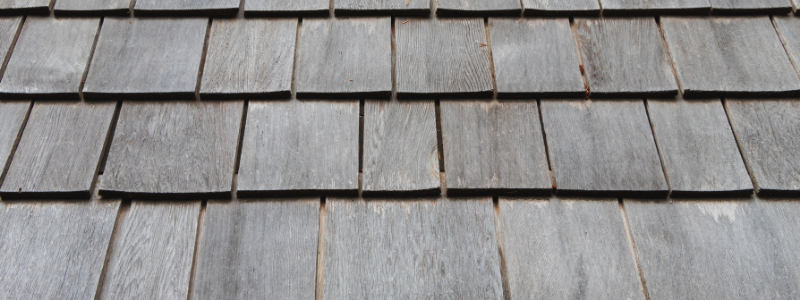
What Does Hail Damage Do to a Roof?
Hail damage can come in many forms because there is a range of variables that can affect the total damage. For example, things like the angle of your roof’s slope, hail size, wind speed, wind direction, the type of roofing, and the age of your roof can all affect the total amount of hail damage.
When it comes to hail damage you need to quickly identify if the damage is cosmetic or functional. Unfortunately, what often looks like cosmetic damage is actually much worse. Here are some of the most common types of damage:
-
Seal Integrity Damage
A shingle with seal integrity hail damage will also damage the shingles that they are next to creating a domino effect. Technically, it is the wind associated with hail damage that makes this so destructive. The hail contact loosens the seal and the wind starts to put pressure on the damage. Ultimately, this is why shingles will fly off.
-
Fiberglass Mat Damage
The contact of hail onto your roof shingles will start to fracture your fiberglass mat. Over time, the hail damage will make your roof shingle start to tear away from the fiberglass mat below. The integrity of your roof’s outer layer is then compromised.
-
Roof Shingle Damage
As the hails starts to damage your seal, and fiberglass, parts of your roof’s shingles will detach. That means that there will be parts of your roof that is completely bare to the natural environment. While we love mother nature; we like our roofs to protect us from it. This exposure to weather could lead to further damage to your home.
-
Granule Damage
If you ever touch the surface of a healthy roof, the shingles will feel like sandpaper. That rough and coarse surface is covered with what are called granules. Over time, your roof will lose granules, especially after hail storms. Often, you’ll see some of the granules inside of your gutters, and if you see a lot of them, it’s time to fix your roof.
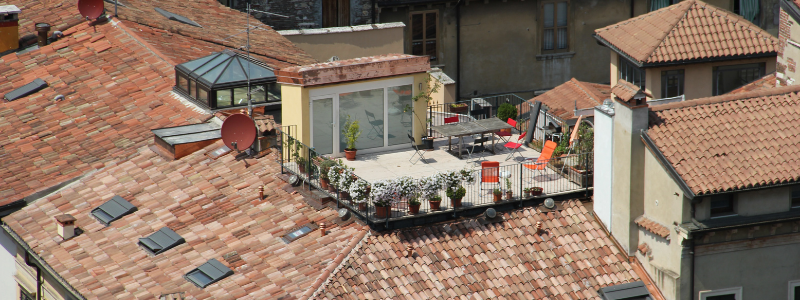
What Does Hail Damage Look Like?
*We do NOT advise climbing up on your roof to check. Instead, walk around the perimeter of your home and look for any visible damage. If you are concerned there may be deeper damage that is not visible, please call a professional to come to take a look.
- Check for missing pieces in the asphalt of the roof. Look for areas on the shingle that have exposed, black substrate. This means the granules of the asphalt have been compromised or knocked off by something.
- Search for bruising in the shingles. Dents from hail are not always completely visible. Run your hand over the shingle to feel for small dimples on the surface.
- Look for cracking in the shingle. Large hail can make a circular crack if the hail hits it hard enough
How Much Hail Damage To Replace Roof?
Replacing your roof is not a small project and while it is crucial that you get it done, when do you know it’s time? Whenever a hail storm passes through in your area, it is recommended that you contact your insurance company for an estimation or contact a professional roofing company like B&M Roofing. Even light hail can damage parts of your roof. A small section of damaged roofing can essentially ‘infect’ the rest of the roof over the long run forcing you to replace your entire roof. However, if you catch it early enough then a roofing repair company can come in and fix the smaller area that needs fixing saving you some money.
Make sure you do your research and find a reputable insurance company to file your claim. Afterwards, it is definitely worth getting multiple reputable roofing professionals to give you estimates. It costs you nothing for these companies to come in and give you their opinions.
At B&M Roofing, we service everything from small residential roofs to large, complicated commercial properties throughout Colorado and surrounding areas. We’re extremely proud of the work we do and confident in our quality of craftsmanship. Don’t wait to inspect your roof or try to do the repairs on your own. Contact B&M Roofing to check your roof for damage and help you repair it.
B&M Hail Damage Inspection Checklist
As we approach the end of winter and as we get closer to prime hail season (March through June), you’re probably wondering what the spring and summer weather will do to your roof. Spring and summer in Colorado bring beautiful colors and temperatures, but with them come severe thunderstorms that are capable of causing significant damage to your home and roof.
Colorado Hail Damage
When we get hail in Colorado, it hits hard and fast, leaving its mark on your roof that can be difficult to see. The type of hail that will fall differs from region to region, affecting our service areas. Depending on the size, shape, and hardness of the hail, damage can come in the form of small indents or actual tears in your roof. If you live in Colorado, chances are you’ll see some sizable hail this spring, which is where it comes in handy to know how to spot damage, so proper roof repairs may be done.
If you know your roof really can’t take another storm season, take a look at our hail damage inspection checklist that walks you through what you need to know and do to ensure your roof replacement goes smoothly. No matter the amount of damage, B&M Roofing can help give estimates on repairs and/or even roof replacement.
Usually, you can’t spot hail damage from the ground because of the small indents it creates on shingles. After the storm, you may see obvious damage to things such as your car or home siding so it is safe to assume the storm also affected your roof. Because the damage from hail is often invisible from the ground, it’s important to have an experienced, professional inspector and insurance claim specialist check your roof as soon as possible.
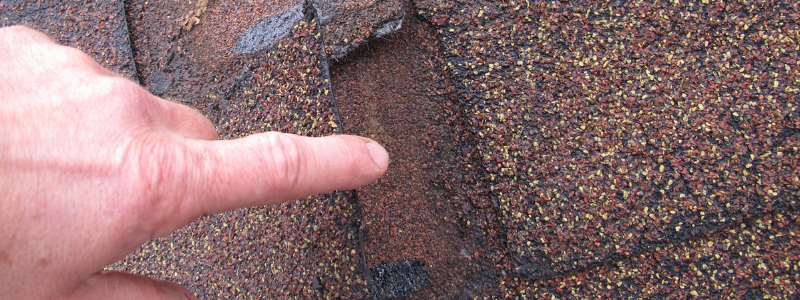
Until then, here is a quick guide on what to do when a hailstorm hits:
Hail Damage Inspection Checklist
Hail damage can sometimes be hard to spot. However, even hail damage that may seem insignificant can prove to be costly. Staying proactive by properly inspecting your roof will help you minimize damage and repair costs.
Assess your roof for storm damage
We do NOT advise climbing up on your roof to do this. Instead, walk around the perimeter of your home and photograph any visible damage. Fairly obvious signs of damage may include dented, discolored, torn, curled, or missing shingles. Given you have 2nd-floor windows that overlook the lower part of the roof, this may be a good vantage point to estimate the amount of hail damage, as you can see flashing and gutters from above instead of below.
Look for leaks & water spots in your attic and ceilings
Roof damage can be deceiving. Even if your roof looks undamaged from the outside, wind and hail may have caused significant leaks internally. Be sure to check your ceilings and light fixtures for signs of water damage. Inspect your attic closely with a flashlight to really get a sense of any hidden damage.
Check your gutters and windows
While your roof shingles may look fully intact, look for dented gutters and downspouts. Dents in other areas, like gutters and roof vents, may point to hidden and serious damage on your rooftop, as well. Do not forget to inspect windows for cracks, loose weatherstripping, and torn screens.
Inspect the area around your home
While some things may be obvious, like fallen tree limbs or broken fences, total damage may be hidden. Assess any damage to lawn furniture and exterior decorations. Check all flat surfaces such as patios and decks for additional signs of hail damage. Another good sign that you may have hail damage on your roof is by checking for damage on other things around the perimeter of your home, like umbrellas, tables, and even your air conditioner. Any dents or hail splatter can mean your roof may also have damage.
Call your insurance company
Refer to your notes, report a claim with your insurance company, and arrange for a more detailed inspection. Remember to save a copy of each picture you take for reference or in case you ever have a problem with the claim (we can help with that, too).
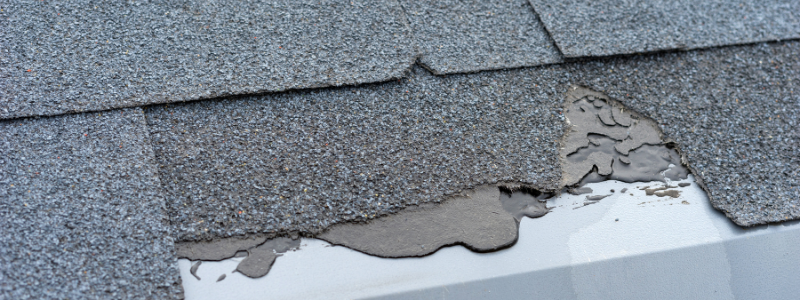
Remember, after a storm, there will likely be a number of roofing contractors and storm chasers competing for your attention. To REALLY be prepared for hail damage, get to know roofers around town and which roofers your neighbors are using. Finding a contractor you trust is a crucial aspect of a smooth roof repair or replacement.
If you need an expert to come and further inspect your roof for hail damage, call B&M Roofing and we’ll inspect your roof. No matter the amount of damage, B&M Roofing can help give estimates on repairs and/or even roof replacement. At B&M Roofing, we come equipped with extensive knowledge and comprehensive industry experience. With more than 60 years of experience, we’re not here to scam you; we’re here to make sure your roof is safe and sturdy.
For more information on B&M Roofing or to simply get to know us before hail season hits, give us a call at 303-443-5843.
Do I Need to Replace Roof after Hail?
Hail storms, unfortunately, have become all too frequent in the Colorado region. In fact, Colorado has seen some of the most costly damages resulting directly from extreme hail storms. In August 2019, Colorado had the second-highest number of hail claims in the United States. So what should you know about hail in this region?
First, hail season in the Centennial state is considered to be from mid-April through mid-September. Your home is susceptible to damage during hail season and it’s important to know and understand repairs and replacements for roofs. The first question many homeowners should ask the experienced Colorado roofers at B&M Roofing is, do I need to replace roof after hail? The answer varies depending on the severity of the damage, but here are some key points to remember.
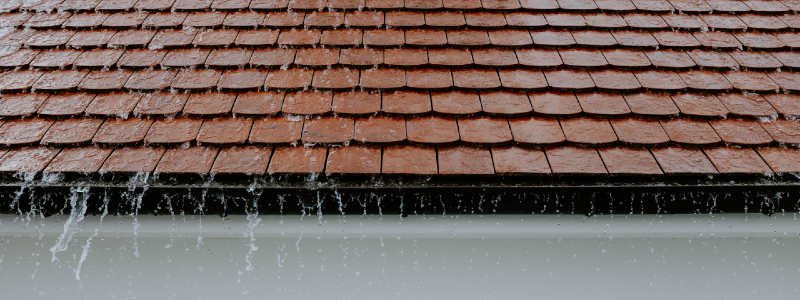
Dangers of Hail
Hail develops when the updraft from a wind carries rain into higher layers of the atmosphere, freezing the rain to create hailstones. Hailstorms negatively impact a number of local areas. It is catastrophic for a number of reasons, but mainly:
- – Hailstorms and the powerful winds that most often accompany them can also destroy crops. During hailstorms, farmers suffer losses that can wipe out their entire crop.
- – Hailstorms pose a high risk for airplanes. Aircraft can be seriously jeopardized if they are caught in the middle of a hailstorm. Planes can also be damaged when they are trying to land or take off in a hailstorm. In 2018 a Mexican airplane crashed when attempting to take off.
- – Hail can be catastrophic for land driving too. Hail can shatter windshields. Reduced visibility can cause roads to become hard to navigate. Hailstones make roads slippery and dangerous to drive on.
- – Hail can be dangerous. Larger hailstones—some as large as golf balls—destroy homes, especially since roofs are unprotected and bear the brunt of the impact.
- – Enormous hailstones can cause fatal head injuries and life-threatening concussions.
In 2014, America experienced the largest insured loss event when hailstorms hammered an area from Colorado to Pennsylvania in mid-May. The result was insured losses of almost three billion dollars. Homeowners were quick to file insurance claims and request inspections for hail damage. Unfortunately, there were long wait times given the influx of homeowner needs. For this reason, it’s important to know – do I need to replace roof after hail?
Hail Storms in Colorado
As we mentioned, Colorado’s hail season extends from mid-April to mid-September. The peak season is May, June and July.
Much of the area northeast of Boulder is open farms and ranches. Cumulonimbus clouds gather over the Rocky Mountains. They bring with them the potential for destruction: lightning, rain, tornados, and hail.
Colorado is especially prone to hail destruction. The state’s position is directly in what weather forecasters call Hail Alley. The state is also a mile closer to those dangerous slate-grey clouds than states like Florida.
Nationally, the annual hail damage is over $10 billion. Not surprising, Colorado is the number two state for hail insurance claims just behind Texas. Hail damages paid out by insurance companies continues to grow.
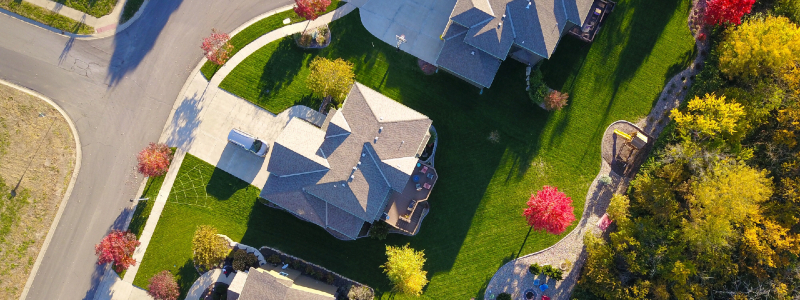
How Hail Impacts the Health of Your Home
Hailstorms are one of the most destructive forces in nature. They fall from great heights, traveling at high speeds.
Severe hailstorms can lead to huge losses to homes and vehicles. Hailstones easily penetrate glass roofs and skylights. Metal roofs are less likely to be compromised by hailstones. However, dents to roofs and automobile surfaces often require repair or replacement.
Hail, water, snow, and ice can all cause major damage to homes and commercial buildings. Due to the intensity of these storms, roofs can leak. This can lead to flooded basements, moldy attics, and collapsing ceilings. High winds that accompany hailstorms can shatter windows, blowing debris around to crash into windows and siding. Metal roof pieces can be ripped off.
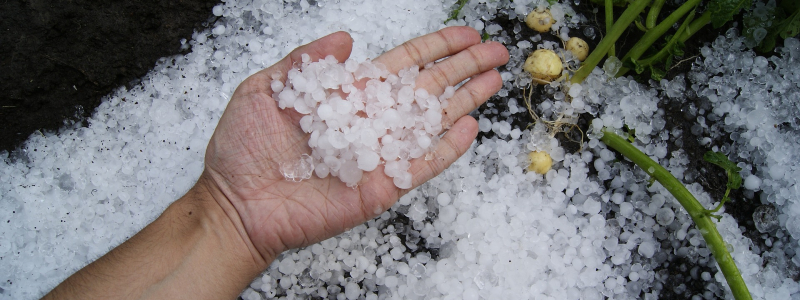
The Process of Inspecting Buildings for Hail Damage
The damage from hailstorms needs to be assessed by an experienced Colorado roofing company. This specialist will look at several aspects of hail damage to your home’s roof.
Roof storm damage is all too common during a hail storm. During the initial inspection, a Colorado roofer at B&M Roofing will look for cracks, splinters, dents, dings, etc. On the more extreme side, they may evaluate holes/punctures, rips, and overall lasting impact on your home. On your roof, they look for things that are present or potential problem leaks down the road. It is crucial that the roof of your home be in good shape. After all, your roof protects the interior of your home.
Hail damage must be assessed or inspected before your insurance company will cover the damage. Before repairs are approved, you will need to get an assessment and an estimate from a Colorado roofing company that specializes in hail damage. They will be able to answer, do I need to replace roof after hail?
Before you contact a roofing specialist, here are some areas to look at:
Metal Roof Damage
Metal roofs are structurally the toughest material to protect your home or business against hail storms. However, metal roofs are not immune to issues caused by sizable hail. Denting on metal roofs may force their replacement if there’s a concern for cracking either immediately or with time. Cracking will eventually lead to leaks and, consequently, more damage to your home. During a check of your metal roof, be sure to inspect the vents, flashing, and metal valleys for dents or ensure that your hired professional metal roofer is paying strict attention to these details. Also, pay special attention to areas constructed of soft metal. Look for evidence of hail damage.
Asphalt and Composition Shingles Hail Damage
Climb to the top of the roof or have a damage specialist do this. Look at the ridge cap for signs of hail damage. For asphalt and composition shingles, hail damage will almost always be evident. Be sure to identify any of the below:
- – Random damage with no discernable pattern.
- – Hail hits that are black in color.
- – Loss of granules, which may expose the roof felt.
- – Asphalt and/or mat that appears shiny.
- – Hail hits that are soft to the touch, like the bruise on an apple.
Other Types of Roofs
There are a variety of roofs and all of them are susceptible to some degree of damage, some more than others. A trust roofing company like B&M Roofing can help you understand how hail damage has impacted your home both short-term and long-term. Contact us for a free inspection or estimate if your home has been damaged by a common occurring hail storm.
Types of Hail Damage
- – Hail causes three types of roof damage: bruising, cracking, and missing granules on the surface of asphalt shingles.
- – Large hailstones can cause cracks on the shingles.
- – Missing pieces on asphalt shingles can be the result of hail damage.
- – Bruising of shingles is harder to see. Finding bruising requires that you feel for small dents. The areas of these small dents will eventually break down.
Other Hail Damage Areas
Inspect other areas including gutters, downspouts, HVAC units, and decks.
Gutters that are dented, dinged, or cracked may need to be replaced. Otherwise, blockages may cause water to seep into the foundation.
Siding and windows can also be damaged by hail. Look for dents and dings. Check for damage to soffits and flashing.

Do I Need to Replace Roof after Hail?
If they are not replaced or repaired, roofs, soffits, gutters, and roof caps can result in severe damage to the interior of your home from water damage, mold growth, and broken windows. If not addressed immediately the damage can spread rapidly. Never ignore potential damage from hail. If a hailstorm has passed through your area, always assume it has done damage to your home until a storm damage specialist has assessed the damage.
When it comes to restoring properties from storm damage, make sure you choose a professional who specializes in roof repair and roof restoration. Look for a roof repair or restoration specialist who has both experience and excellent references. The roof of your house is its first defense against internal damage. It never pays to ignore hail damage or assume there was none simply because your untrained eye did not note any. Whether your structure needs a few repairs or major reconstruction, a knowledgeable, experienced roof repair and restoration specialist can bring your roof back to top condition.
If you are unsure about the condition of your home after a hailstorm, it is wise to contact an experienced Colorado roofing company for a Denver roof inspection. B & M Roofing will provide a free inspection and estimate to replace your roof.
When the Weather Gets In: Emergency Roof Repair
There’s almost nothing like the moment of sheer panic when you first hear the sound of dripping water coming from the ceiling, or golf ball-sized hail bouncing off of your roof. When disaster strikes, B&M Roofing of Colorado offers Emergency Roof Repair services to minimize the time your roof and home are left exposed to further damage.
Roof damage comes in all shapes and sizes, but in some cases it constitutes a true emergency. In particular, leaks can cause costly and potentially dangerous issues in your home if left unchecked.
Attics and ceilings may become moldy, which can pose health risks to you and your family. Residual moisture can pose a fire threat in the event of shorted wires in your attic or ceiling. In the long run, unaddressed damage can even severely impact the structural integrity of your home. Additionally, in the most serious cases, wind or hail damage can also lead to permanent damage.
Any and all of these complications that can arise from unchecked roof damage will put your family in danger and lead to expensive, painstaking repairs in the future. It is extremely important that you act as quickly and decisively as possible after noticing an issue with your roof in order to protect your home and loved ones.
You can’t put off repairing roof damage until it works for a roofing company’s schedule. Emergency response estimators and teams are here when your roof needs immediate attention. They’re highly trained to assist you with the following issues:
Leak identification
Roof damage analysis
Emergency repairs
Next time your roof can’t wait, trust B&M’s fast and affordable Emergency Roof Repair services. Call today at 303.443.5843 to schedule a visit from our emergency repair team, or visit our Leak Repair Request Page to schedule a timely visit from a team member.





































